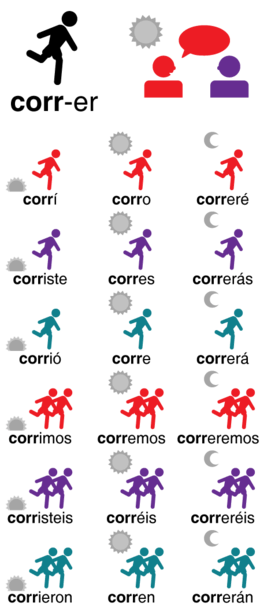Grammatical person

In this image, each row represents person and number: 1st person, 2nd person informal and 2nd person formal and 3rd person.
Columns represent tense (image: morning - past, noon - present, night - future).
Grammatical person, in linguistics, is the grammatical distinction between deictic references to participant(s) in an event; typically the distinction is between the speaker (first person), the addressee (second person), and others (third person). Grammatical person typically defines a language's set of personal pronouns. It also frequently affects verbs, sometimes nouns, and possessive relationships.
Grammatical person in nominative case English pronouns
| Pronoun | Person/number | Gender |
|---|---|---|
| Standard | ||
| I | First person singular | |
| we | First person plural | |
| you | Second person singular / second person plural | |
| he | Third person masculine singular | masculine |
| she | Third person feminine singular | feminine |
| it | Third person neuter (and inanimate) singular | neuter |
| they | Third person plural | |
| Dialectical | ||
| me | First person singular, dialectal Caribbean English and colloquial special uses | |
| thee | Second person singular, occasional use by Quakers. | |
| allyuh | Second person plural, many English-based creole languages, dialectal Caribbean English. | |
| unu | Second person plural, many English-based creole languages, dialectal Caribbean English. | |
| y'all | Second person plural, dialectal Southern American and African American English | |
| ye | Second person plural, dialectal Hiberno-English | |
| yinz | Second person plural, Scots, dialectal Scottish English, Pittsburgh English | |
| you guys | Second person plural, dialectal American English and Canadian English | |
| you(r) lot | Second person plural, dialectal British English | |
| youse | Second person plural, many urban American dialects like New York City English and Chicago English | |
| yourse | Second person plural, Scots, dialect Central Scottish Lowlands, Scouse, Cumbrian, Tyneside, Hiberno English. | |
| us | First person plural, as in us guys are going out to eat | |
| them | Third person plural, as in them girls are in trouble | |
| Archaic | ||
| thou | Second person singular | |
| ye | Second person plural | |
Related classifications
In Indo-European languages, first-, second-, and third-person pronouns are typically also marked for singular and plural forms, and sometimes dual form as well (grammatical number). Some languages, especially European ones, distinguish degrees of formality and informality (T-V distinction).
Some other languages use different classifying systems, especially in the plural pronouns. One frequently found difference not present in most Indo-European languages is a contrast between inclusive and exclusive "we": a distinction of first-person plural pronouns between including or excluding the addressee.
Some other languages have much more elaborate systems of formality that go well beyond the T-V distinction, and use many different pronouns and verb forms that express the speaker's relationship with the people they are addressing. Many Malayo-Polynesian languages, such as Javanese and Balinese, are well known for their complex systems of honorifics; Japanese and Korean also have similar systems to a lesser extent.
Effect on verbs
In many languages, the verb takes a form dependent on the person of the subject and whether it is singular or plural. In English, this happens with the verb to be as follows:
- I am (first-person singular)
- you are/thou art (second-person singular)
- he, she, one or it is (third-person singular)
- we are (first-person plural)
- you are/ye are (second-person plural)
- they are (third-person plural)
Other verbs in English take the suffix -s to mark the present tense third person singular.
In many languages, such as French, the verb in any given tense takes a different suffix for any of the various combinations of person and number of the subject.
Additional persons
The grammars of some languages divide the semantic space into more than three persons. The extra categories may be termed fourth person, fifth person, etc. Such terms are not absolute but can refer depending on context to any of several phenomena.
Some Algonquian languages and Salishan languages divide the category of third person into two parts: proximate for a more topical third person, and obviative for a less topical third person. The obviative is sometimes called the fourth person.
The term fourth person is also sometimes used for the category of indefinite or generic referents, which work like one in English phrases such as "one should be prepared" or people in people say that..., when the grammar treats them differently from ordinary third-person forms. The so-called "zero person"[1][2] in Finnish and related languages, in addition to passive voice may serve to leave the subject-referent open. Zero person subjects are sometimes translated as "one," but the problem with that is that English language constructions involving one, e.g. "One hopes that will not happen," are rare and could be considered to be expressing an overly academic tone, while Finnish sentences like "Ei saa koskettaa" ("0 cannot touch") are recognizable to, and even used by, young children.
See also
- English personal pronouns
- Gender-neutral pronoun
- Gender-specific pronoun
- Generic antecedents
- Generic you
- Grammatical conjugation
- Grammatical number
- Illeism
- Personal pronoun
- Singular they
- Verb
References
- ↑ Laitinen, Lea (2006). Helasvuo, Marja-Liisa; Campbell, Lyle, eds. "0 person in Finnish: A grammatical resource for construing human evidence". Grammar from the Human Perspective: Case, space and person in Finnish. Amsterdam: Benjamins: 209–232.
- ↑ Leinonen, Marja (1983). "Generic zero subjects in Finnish and Russian". Scando-Slavica (29): 143–161.
- de Gaynesford, Robert Maximillian (2006). I: The Meaning of the First Person Term. Oxford: Oxford University Press.
External links
| Look up grammatical person in Wiktionary, the free dictionary. |